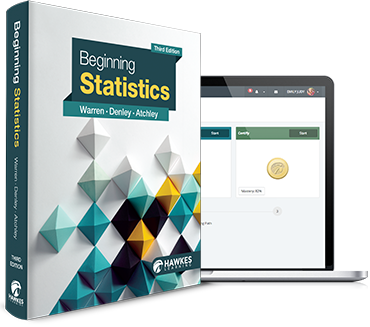
Beginning Statistics, 3rd Edition
By Carolyn Warren Wiley, Kimberly Denley, and Emily Atchley
Overview
The third edition of Beginning Statistics is designed to help students develop a solid foundation and understanding of statistics. The information covered includes methods of conducting and critiquing a statistical study, hypothesis testing, confidence intervals, and regression.
The textbook and software accentuate the importance of technology in today's world and provide a thorough description of how to use popular computational technologies. The software's interactive Tutor and informational Learn mode directly link to specific technology instructions whenever necessary.
Updates to the third edition include new and streamlined questions with fewer steps, a modernized methodology for hypothesis testing, the addition of heat maps, current data, and more. An emphasis is placed on the ability to use different methodologies to arrive at correct answers.
A curated list of resources for this title is available at stat.hawkeslearning.com. This companion website features:
-
Free, real-world data sets
-
Step-by-step instructions for TI calculators, Excel, Minitab®, SPSS, JMP, and R
-
Chapter projects that apply lessons to real-life scenarios
-
Links to data visualization resources
-
External videos explaining key topics
Bundling options include Minitab®, SPSS, JMP, and Rguroo.
Products
Formats: Software, eBook, Textbook
| Product | ISBN |
|---|---|
| Software + eBook + Textbook | 978-1-64277-280-7 |
| Software + eBook | 978-1-64277-279-1 |
Table of Contents
- Chapter 1: Introduction to Statistics
- 1.1 Getting Started
- 1.2 Data Classification
- 1.3 The Process of a Statistical Study
- 1.4 How to Critique a Published Study
- Chapter 1 Review
- Chapter 2: Graphical Descriptions of Data
- 2.1 Frequency Distributions
- 2.2 Graphical Displays of Data
- 2.3 Analyzing Graphs
- Chapter 2 Review
- Chapter 3: Numerical Descriptions of Data
- 3.1 Measures of Center
- 3.2 Measures of Dispersion
- 3.3 Measures of Relative Position
- Chapter 3 Review
- Chapter 4: Probability, Randomness, and Uncertainty
- 4.1 Introduction to Probability
- 4.2 Addition Rules for Probability
- 4.3 Multiplication Rules for Probability
- 4.4 Combinations and Permutations
- 4.5 Combining Probability and Counting Techniques
- Chapter 4 Review
- Chapter 5: Discrete Probability Distributions
- 5.1 Discrete Random Variables
- 5.2 Binomial Distribution
- 5.3 Poisson Distribution
- 5.4 Hypergeometric Distribution
- Chapter 5 Review
- Chapter 6: Normal Probability Distributions
- 6.1 Introduction to the Normal Distribution
- 6.2 The Standard Normal Distribution
- 6.3 Finding Probability Using a Normal Distribution
- 6.4 Finding Values of a Normally Distributed Random Variable
- 6.5 Approximating a Binomial Distribution Using a Normal Distribution
- Chapter 6 Review
- Chapter 7: The Central Limit Theorem
- 7.1 Sampling Distributions and the Central Limit Theorem
- 7.2 Central Limit Theorem with Means
- 7.3 Central Limit Theorem with Proportions
- Chapter 7 Review
- Chapter 8: Confidence Intervals
- 8.1 Estimating Population Means (σ Known)
- 8.2 Student's t-Distribution
- 8.3 Estimating Population Means (σ Unknown)
- 8.4 Estimating Population Proportions
- 8.5 Estimating Population Variances
- Chapter 8 Review
- Chapter 9: Confidence Intervals for Two Samples
- 9.1 Comparing Two Population Means (σ Known, Independent Samples)
- 9.2 Comparing Two Population Means (σ Unknown, Independent Samples)
- 9.3 Comparing Two Population Means (σ Unknown, Dependent Samples)
- 9.4 Comparing Two Population Proportions
- 9.5 Comparing Two Population Variances
- Chapter 9 Review
- Chapter 10: Hypothesis Testing
- 10.1 Fundamentals of Hypothesis Testing
- 10.2 Hypothesis Testing for Population Means (σ Known)
- 10.3 Hypothesis Testing for Population Means (σ Unknown)
- 10.4 Hypothesis Testing for Population Proportions
- 10.5 Hypothesis Testing for Population Variances
- 10.6 Chi-Square Test for Goodness of Fit
- 10.7 Chi-Square Test for Association
- Chapter 10 Review
- Chapter 11: Hypothesis Testing (Two or More Populations)
- 11.1 Hypothesis Testing: Two Population Means (σ Known)
- 11.2 Hypothesis Testing: Two Population Means (σ Unknown)
- 11.3 Hypothesis Testing: Two Population Means (σ Unknown, Dependent Samples)
- 11.4 Hypothesis Testing: Two Population Proportions
- 11.5 Hypothesis Testing: Two Population Variances
- 11.6 ANOVA (Analysis of Variance)
- Chapter 11 Review
- Chapter 12: Regression, Inference, and Model Building
- 12.1 Scatter Plots and Correlation
- 12.2 Linear Regression
- 12.3 Regression Analysis
- 12.4 Multiple Regression
- Chapter 12 Review
- Appendix
- A.1 Constructing Samples
- A.2 Games of Chance
- A.3 Name that Distribution
- A.4 Type II Errors
- A.5 Direct Mail
- A.6 Statistical Process Control
- A.7 Choosing the Correct Statistic for Estimating a Population Mean